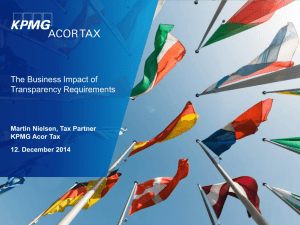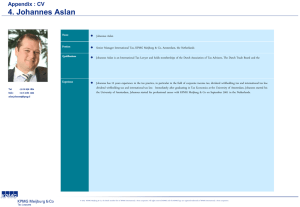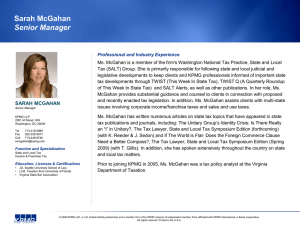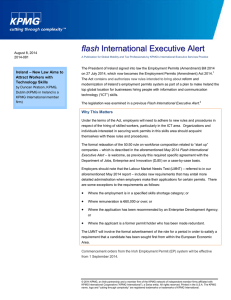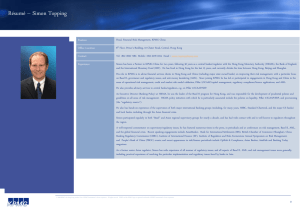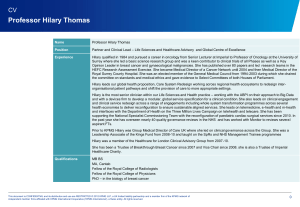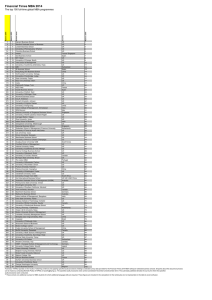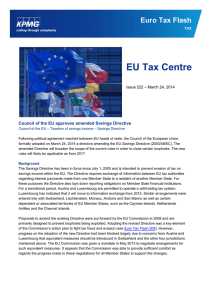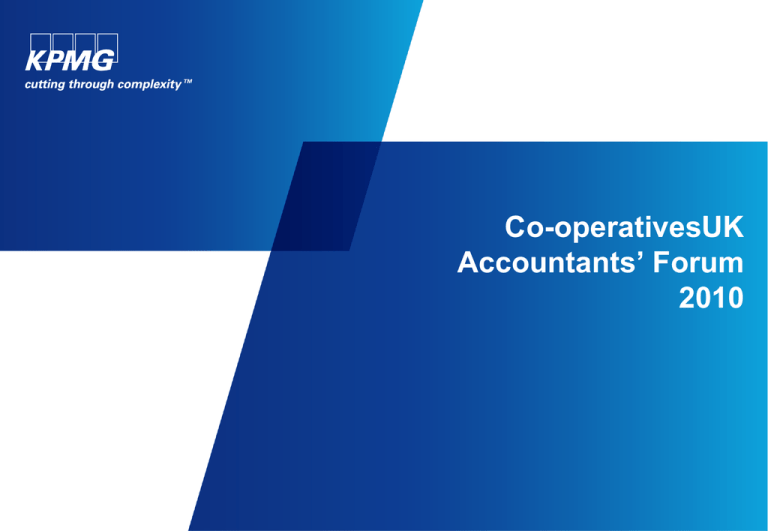
Co-operativesUK
Accountants’ Forum
2010
2010 update
Nicola Quayle
What is worrying people in 2010?
What? Why? When?
Refinancings
Bribery and
corruption
act
© 2010 KPMG LLP, a UK limited liability partnership, is a subsidiary of KPMG Europe LLP and a member firm of the KPMG
network of independent member firms affiliated with KPMG International Cooperative, a Swiss entity. All rights reserved.
iXBRL
Carbon
Reduction
Commitment
2
Refinancing graph
Maturing investment grade loans in EMEA
Source: Thomson Reuters LPC/DealScan
© 2010 KPMG LLP, a UK limited liability partnership, is a subsidiary of KPMG Europe LLP and a member firm of the KPMG
network of independent member firms affiliated with KPMG International Cooperative, a Swiss entity. All rights reserved.
3
Our advice
Recognise there are less banks around!
Remaining banks are tight on liquidity
Go early – it takes longer
Robust model
Run sensitivities
Explain your business – 3 years historical / 3 year future
Expect more diligence
Work on new multiples
Covenants will be tighter
Treat bankers with respect!
Don’t be last in the queue!
© 2010 KPMG LLP, a UK limited liability partnership, is a subsidiary of KPMG Europe LLP and a member firm of the KPMG
network of independent member firms affiliated with KPMG International Cooperative, a Swiss entity. All rights reserved.
4
iXBRL – What, Why, When
WHY?
HMRC
will be able to electronically review accounts and
automatically identify inconsistencies and inaccuracies through
ratio analysis and electronic profiling. It will also facilitate the
identification and closure of tax loopholes
The
process will give HMRC paperless storage providing quick
and easy access to significant volumes of information.
XBRL
has already been adopted by regulatory bodies in the US,
Japan, Australia, Belgium and the Netherlands
© 2010 KPMG LLP, a UK limited liability partnership, is a subsidiary of KPMG Europe LLP and a member firm of the KPMG
network of independent member firms affiliated with KPMG International Cooperative, a Swiss entity. All rights reserved.
5
iXBRL – What, Why, When
WHEN?
All
corporate tax returns filed after 31 March 2011 must be in
iXBRL format along with supporting computations and accounts
All
companies which are required to submit a tax return must
comply
© 2010 KPMG LLP, a UK limited liability partnership, is a subsidiary of KPMG Europe LLP and a member firm of the KPMG
network of independent member firms affiliated with KPMG International Cooperative, a Swiss entity. All rights reserved.
6
How does this affect my business?
COST
The move to electronic submission passes the cost of preparing the data to the tax
payer
ONEROUS
In the majority of cases the only place where all of the required data is maintained in
one place is the statutory accounts. These are typically in Word or Excel formats which
do not facilitate direct conversion to iXBRL
The process of converting statutory accounts to iXBRL is onerous and manually
intensive
NO EXEMPTIONS
The requirements apply to all companies which file a tax return regardless of size.
There are no exemptions from the rule
LOOKING FORWARD
As disclosure requirements change, so does the format of statutory accounts
© 2010 KPMG LLP, a UK limited liability partnership, is a subsidiary of KPMG Europe LLP and a member firm of the KPMG
network of independent member firms affiliated with KPMG International Cooperative, a Swiss entity. All rights reserved.
7
Technical update
IASB work programme until 2011
Discussion Paper
Exposure Draft
Final Standard
Guidance
FSP - Disc Ops
Roundtable
FSP – IAS 1 and
IAS 7
* Indicates Practice Statement
FI w/equity
Liabilities
Leases
Narrow Scope
Income Taxes
Insurance
Consolidation
(Invest Co)
FSP – Presentation
of OCI
Narrow Scope
Income Taxes
Revenue
Recognition
Consolidation
(Invest Co)
Revenue
Recognition
Mgmt
Commentary*
FI Asset & Liab
Offsetting
CF Phase D
Fair Value
Measurement
Annual Improv. IV
FI C&M Liabilities
Leases
CF Phase A
Annual Improv. IV
FSP - Disc Ops
Defined Benefit
Plans
Emission Trading
FI
Impairment
Hedging
Consolidation
CF Phase B
FSP – IAS 1 and
IAS 7
Termination
Benefits
Insurance
FI Hedge
Accounting
Joint Ventures
Consolidation
disclosures
CF Phase C
FI w/equity
Extractive
Activities
CF Phase C
FI Asset & Liab
Offsetting
2010 Q4
© 2010 KPMG LLP, a UK limited liability partnership, is a subsidiary of KPMG Europe LLP and a member firm of the KPMG
network of independent member firms affiliated with KPMG International Cooperative, a Swiss entity. All rights reserved.
2011 Q1
2011 Q2+
9
What’s driving this frantic pace?
Responding to financial crisis/G20
FASB-IASB MoU
SEC workplan leaves little room
to manoeuvre
Chair and 5 other IASB members retire
by June 2011
End of the 10-year Tweedie era
IASB actively recruiting
Practical implications
Push to publish by June 2011
Reconsideration of other projects
in progress
Change in tone/priorities?
© 2010 KPMG LLP, a UK limited liability partnership, is a subsidiary of KPMG Europe LLP and a member firm of the KPMG
network of independent member firms affiliated with KPMG International Cooperative, a Swiss entity. All rights reserved.
10
The future of UK GAAP
The end of UK GAAP
© 2010 KPMG LLP, a UK limited liability partnership, is a subsidiary of KPMG Europe LLP and a member firm of the KPMG
network of independent member firms affiliated with KPMG International Cooperative, a Swiss entity. All rights reserved.
12
Exposure Draft – Future of financial reporting
Proposals for a three tier framework
Includes two draft FRSs:
Application of Financial Reporting Requirements
Financial Reporting Standard for Medium Sized Entities
Includes explanation of proposals, impact assessment and two new standards
Comment deadline is 30 April 2011
Effective for accounting periods beginning on or after 1 July 2013
Early adoption permitted
© 2010 KPMG LLP, a UK limited liability partnership, is a subsidiary of KPMG Europe LLP and a member firm of the KPMG
network of independent member firms affiliated with KPMG International Cooperative, a Swiss entity. All rights reserved.
13
Proposed regime
Tier
Accounting
regime
Type of entity
Example
Tier 1
EU-IFRS*
EU-listed entities
Parent company in
a listed group
AIM entities
Other publicly accountable
entities
Tier 2
FRSME*
Large and medium non-publicly
Subsidiaries in a
accountable entities
listed group (not
publicly
accountable)
Small publicly accountable
entities that are prudentially
regulated
Tier 3
FRSSE
Small non-publicly accountable
Small private
entities
companies
*Certain disclosure exemptions proposed for non-publicly accountable subsidiaries
© 2010 KPMG LLP, a UK limited liability partnership, is a subsidiary of KPMG Europe LLP and a member firm of the KPMG
network of independent member firms affiliated with KPMG International Cooperative, a Swiss entity. All rights reserved.
14
Key differences between IFRS for SMEs and the proposed FRSME
Conflicts with legal requirements
Consolidation
Income tax
Disclosures
Dormant companies
© 2010 KPMG LLP, a UK limited liability partnership, is a subsidiary of KPMG Europe LLP and a member firm of the KPMG
network of independent member firms affiliated with KPMG International Cooperative, a Swiss entity. All rights reserved.
15
The real impact
Selected GAAP differences
Goodwill
Current UK GAAP
Proposed FRSME
EU-IFRS
Amortised over rebuttable max life of
20 years
Intangibles generally subsumed within
goodwill
Presumed life of 5 years or less
unless goodwill has a longer UEL
Intangibles recognised separately
No amortisation; annual impairment
test
Intangibles recognised separately
Derivatives
Generally off balance sheet (non-FRS
26)
On balance sheet
On balance sheet
Net investment
hedging
SSAP 20 cover concept in individual
accounts - can hedge with loans
On consolidation only – cannot hedge
with loans unless IAS 39 fully applied
On consolidation only
Functional currency
Level of autonomy not considered in
determining functional currency
Determination of functional currency –
consider if subsidiary is autonomous
Determination of functional currency –
consider if subsidiary is autonomous
Deferred tax
Temporary difference basis
Initial recognition exemption applies
Timing difference basis
Permanent differences
Temporary difference basis
Initial recognition exemption applies
Borrowing costs
May capitalise
Must expense
Must capitalise when criteria met
Development costs
May capitalise
Must expense
Must capitalise when criteria met
Group defined benefit
plans
Can all be off balance sheet (individual
accounts)
Treatment unclear
Must be in at least one individual
company balance sheet
© 2010 KPMG LLP, a UK limited liability partnership, is a subsidiary of KPMG Europe LLP and a member firm of the KPMG
network of independent member firms affiliated with KPMG International Cooperative, a Swiss entity. All rights reserved.
16
How will it affect you in practice?
Area
Potential impact
Distributable profits
Change in accounting policies may create dividend
traps
Systems and internal
control environment
Systems will need to be updated to calculate EU-
© 2010 KPMG LLP, a UK limited liability partnership, is a subsidiary of KPMG Europe LLP and a member firm of the KPMG
network of independent member firms affiliated with KPMG International Cooperative, a Swiss entity. All rights reserved.
IFRS/FRSME compliant data
17
How will it affect you in practice?
Area
Potential impact
Training and resource
Accounting staff will be required to be trained in EU-
IFRS and/or the FRSME
Additional time will be required to effect the
changes
Financial covenants
Impact on interest cover ratios and other KPIs
Bonus scheme
Potential implications for performance-related
remuneration schemes
© 2010 KPMG LLP, a UK limited liability partnership, is a subsidiary of KPMG Europe LLP and a member firm of the KPMG
network of independent member firms affiliated with KPMG International Cooperative, a Swiss entity. All rights reserved.
18
Will it affect the tax I pay?
Will not affect cash tax
Research and development
Pensions
Share-based payments
Assets taxed under capital gains
Borrowing costs whether expensed or capitalised in fixed assets
Will affect cash tax
Tax deductible goodwill – unless 4% election is made
Financial instruments – unless the disregard regulations apply
Some tax planning – UK to UK financing ideas that rely on specific accounting
treatments
Rent free periods/upward only rent reviews
© 2010 KPMG LLP, a UK limited liability partnership, is a subsidiary of KPMG Europe LLP and a member firm of the KPMG
network of independent member firms affiliated with KPMG International Cooperative, a Swiss entity. All rights reserved.
19
IASB Exposure Drafts
Leases and Revenue
Leasing
© 2010 KPMG LLP, a UK limited liability partnership, is a subsidiary of KPMG Europe LLP and a member firm of the KPMG
network of independent member firms affiliated with KPMG International Cooperative, a Swiss entity. All rights reserved.
21
Exposure Draft Leases
The “right-of-use” model
Right to use
leased asset
Lessor
Lessee
Underlying asset
Right-of-use
asset
Consideration
(lease rentals)
Performance
obligation
approach
Derecognition
approach
© 2010 KPMG LLP, a UK limited liability partnership, is a subsidiary of KPMG Europe LLP and a member firm of the KPMG
network of independent member firms affiliated with KPMG International Cooperative, a Swiss entity. All rights reserved.
Recognise
“right-of-use”
asset
Recognise
liability to pay
rentals
22
Key impacts
Leases “on balance sheet”
Increases in assets and liabilities
Impact on key ratios and covenants
Impact on income statement
Front-loading of expenses vs. increase in EBITDA
© 2010 KPMG LLP, a UK limited liability partnership, is a subsidiary of KPMG Europe LLP and a member firm of the KPMG
network of independent member firms affiliated with KPMG International Cooperative, a Swiss entity. All rights reserved.
23
Example income statement impact
Company has an office lease that is 15 years with a tenant-only break clause at 10 years:
Rent £50,000 p.a.
No Retail Price Index reviews
6% discount factor
© 2010 KPMG LLP, a UK limited liability partnership, is a subsidiary of KPMG Europe LLP and a member firm of the KPMG
network of independent member firms affiliated with KPMG International Cooperative, a Swiss entity. All rights reserved.
24
Key impacts
Leases “on balance sheet”
Increases in assets and liabilities
Impact on key ratios and covenants
Impact on income statement
Front-loading of expenses vs. increase in EBITA
New liability measurement basis
Reassessment → volatility
Likely effective date 2013 – 2014?
© 2010 KPMG LLP, a UK limited liability partnership, is a subsidiary of KPMG Europe LLP and a member firm of the KPMG
network of independent member firms affiliated with KPMG International Cooperative, a Swiss entity. All rights reserved.
25
Initial measurement – lease liability
Lease liability
PV of lease payments
Includes expectations
about
Lease term
Contingent
rentals
RV guarantees
Purchase options
Term option penalties
Discount rate
© 2010 KPMG LLP, a UK limited liability partnership, is a subsidiary of KPMG Europe LLP and a member firm of the KPMG
network of independent member firms affiliated with KPMG International Cooperative, a Swiss entity. All rights reserved.
26
What is the lease term?
Lessee has entered into a non-cancellable lease contract with Lessor to lease a building.
The lease term is 4 years, and Lessee has the option to extend the lease either by
another 2 years or by another 4 years
At inception of the lease, Lessee’s expectations about exercising the option to extend the
lease term are as follows:
Lease term of 4 years i.e. option to extend not exercised: 40%
Exercise of option to extend by 2 years: 30%
Exercise of option to extend by 4 years: 30%
What lease term should be used to calculate the present value of the obligation to make
lease payments?
© 2010 KPMG LLP, a UK limited liability partnership, is a subsidiary of KPMG Europe LLP and a member firm of the KPMG
network of independent member firms affiliated with KPMG International Cooperative, a Swiss entity. All rights reserved.
27
Initial measurement – lease liability
Lease liability
PV of lease payments
Includes expectations
about
Lease term
Contingent
rentals
RV guarantees
Purchase options
Term option penalties
Discount rate
© 2010 KPMG LLP, a UK limited liability partnership, is a subsidiary of KPMG Europe LLP and a member firm of the KPMG
network of independent member firms affiliated with KPMG International Cooperative, a Swiss entity. All rights reserved.
28
Discount rate
Lessee’s incremental borrowing rate
The rate of interest that, at the date
of inception of the lease, the lessee
would have to pay to borrow over a
similar term, and with a similar
security, the funds necessary to
purchase a similar underlying asset.
© 2010 KPMG LLP, a UK limited liability partnership, is a subsidiary of KPMG Europe LLP and a member firm of the KPMG
network of independent member firms affiliated with KPMG International Cooperative, a Swiss entity. All rights reserved.
OR
if readily
determinable
Rate the lessor charges the lessee
A discount rate that takes
into account the nature of the
transaction as well as the specific
terms of the lease such as
lease payments, lease term and
contingent rentals
29
Initial measurement – right-of-use asset
Right of Use Asset = Initial lease liability + initial direct costs
Initial direct costs
Commissions
Legal fees
Costs in respect of evaluating and recording
guarantees, collateral and other security
arrangements
Costs associated with negotiating lease terms
Costs of preparing and processing lease
documents
Costs of closing the transaction
Other costs that are incremental and
directly attributable to negotiating and
arranging the lease
© 2010 KPMG LLP, a UK limited liability partnership, is a subsidiary of KPMG Europe LLP and a member firm of the KPMG
network of independent member firms affiliated with KPMG International Cooperative, a Swiss entity. All rights reserved.
General overheads
Advertising costs
Costs associated with soliciting potential leases
Costs of servicing existing leases
Costs related to other ancillary activities
30
Subsequent measurement
Lease liability
Amortised cost using the effective interest method
Re-assess lease payments if facts and circumstances indicate a significant change to
amount of lease liability
Generally, do not revise discount rate used at initial recognition
Accounting for reassessment of liability
P&L, if relates to current period
Otherwise generally adjust ‘right-of-use’ asset
Right-of-use asset
Amortise over lease term (or underlying asset life if shorter)
Impairment test in accordance with IAS 36 Impairment of Assets
© 2010 KPMG LLP, a UK limited liability partnership, is a subsidiary of KPMG Europe LLP and a member firm of the KPMG
network of independent member firms affiliated with KPMG International Cooperative, a Swiss entity. All rights reserved.
31
Lessor Accounting: Sub-leasing
Company has entered into sub-lease agreements for unutilised property
space in the UK
Accounting for head lease
Dr ‘right of use’ asset
Cr lease liability (for future lease payments)
Accounting for sub-lease
Dr lease asset (lease payment receivable)
Cr lease liability for obligation to deliver use of asset
(performance obligation approach)
or Cr lessee ‘right of use’ asset (de-recognition approach)
© 2010 KPMG LLP, a UK limited liability partnership, is a subsidiary of KPMG Europe LLP and a member firm of the KPMG
network of independent member firms affiliated with KPMG International Cooperative, a Swiss entity. All rights reserved.
32
Exposure Draft Revenue from contracts with customers
The Proposed Model
Step 1:
Identify the
contract
Step 2:
Identify the
separate
performance
obligations in
the contract
Contract
Performance
obligation 1
Performance
obligation 2
Transaction price for the contract
Transaction
price allocated
to performance
obligation 1
Recognise
revenue
© 2010 KPMG LLP, a UK limited liability partnership, is a subsidiary of KPMG Europe LLP and a member firm of the KPMG
network of independent member firms affiliated with KPMG International Cooperative, a Swiss entity. All rights reserved.
Step 3:
Determine the
transaction
price
Transaction
price allocated
to performance
obligation 2
Step 4:
Allocate the
transaction
price to the
separate
performance
obligations
Recognise
revenue
Step 5:
Recognise
revenue as
each
performance
obligation is
satisfied
33
Step 2: Identify the separate performance obligations in the contract
Is promised good or service distinct from other goods or services in the contract ?
Yes
No
Separate performance obligations
Combine good or service with other
goods or services
A promised good or service is distinct from others if
the entity or another entity sells an identical or similar good or service separately; or
the entity could sell the good or service separately, because it has
a distinct function; and
a distinct margin.
© 2010 KPMG LLP, a UK limited liability partnership, is a subsidiary of KPMG Europe LLP and a member firm of the KPMG
network of independent member firms affiliated with KPMG International Cooperative, a Swiss entity. All rights reserved.
34
Step 5: Recognise revenue when a performance obligation is satisfied
A performance obligation is satisfied when the customer obtains control of a good or
service. Control is transferred to the customer when:
The customer has the ability to
direct the use of the asset
The customer has the ability to
receive the benefit from the asset
i.e. the present right to:
i.e. the present right to obtain
substantially all of the potential cash
flows from that asset (either cash
inflow or reduction in cash outflow)
through use, sale, exchange, etc.
use
the asset for its
remaining economic life; or
to
consume the asset in the
customer’s activities
and
Control also includes the ability to prevent other parties from directing the use of and
receiving the benefit from the asset
© 2010 KPMG LLP, a UK limited liability partnership, is a subsidiary of KPMG Europe LLP and a member firm of the KPMG
network of independent member firms affiliated with KPMG International Cooperative, a Swiss entity. All rights reserved.
35
Step 5: Recognise revenue – indicators that control is transferred
The customer has
physical possession
The customer has
legal title
Indicators that the
customer has obtained
control of a good or service
The customer
has an unconditional
obligation to pay
The design or function
is customer-specific
No single factor in isolation is decisive.
© 2010 KPMG LLP, a UK limited liability partnership, is a subsidiary of KPMG Europe LLP and a member firm of the KPMG
network of independent member firms affiliated with KPMG International Cooperative, a Swiss entity. All rights reserved.
36
Specific application issues
Sale of product with a right of return
Product warranties
Customer incentives
Licensing and right of use
Bill-and-hold arrangements
Consignment arrangements
© 2010 KPMG LLP, a UK limited liability partnership, is a subsidiary of KPMG Europe LLP and a member firm of the KPMG
network of independent member firms affiliated with KPMG International Cooperative, a Swiss entity. All rights reserved.
37
Key changes and their impact
Key change
Implication
Segmentation of contracts into
performance obligations
May accelerate or defer revenue
Revenue recognition based on
transfer of control
Requires judgement. May accelerate
or defer revenue
Withdrawal of percentage of
completion method
Deferral of revenue if control not
passed continuously to customer
Measure revenue using probability
weighted outcome approach
More judgement and
estimates required
Reduction in revenue
May accelerate or defer revenue
© 2010 KPMG LLP, a UK limited liability partnership, is a subsidiary of KPMG Europe LLP and a member firm of the KPMG
network of independent member firms affiliated with KPMG International Cooperative, a Swiss entity. All rights reserved.
38
The UK Bribery Act 2010
Louise Thompson
The UK Bribery Act – a brief overview
• UK Bribery Act 2010
• Consequences of violation
• The usual suspects and red flags
• Managing the risk
• Questions
© 2010 KPMG LLP, a UK limited liability partnership, is a subsidiary of KPMG Europe LLP and a member firm of the KPMG
network of independent member firms affiliated with KPMG International Cooperative, a Swiss entity. All rights reserved.
Recent Enforcement Actions
© 2010 KPMG LLP, a UK limited liability partnership, is a subsidiary of KPMG Europe LLP and a member firm of the KPMG
network of independent member firms affiliated with KPMG International Cooperative, a Swiss entity. All rights reserved.
UK Bribery Act 2010 - objective
"to provide a modern, single piece of legislation
criminalising bribery, allowing the police,
prosecutors and the courts to tackle bribery
effectively whether committed at home or abroad”.
Enacted on 8 April 2010 and Received Royal Assent
– scheduled to be in force April 2011.
© 2010 KPMG LLP, a UK limited liability partnership, is a subsidiary of KPMG Europe LLP and a member firm of the KPMG
network of independent member firms affiliated with KPMG International Cooperative, a Swiss entity. All rights reserved.
Draft - For Discussion and Demonstrative Purposes Only
UK Bribery Act
Replaces existing common law offence of bribery; creates new offences covering:
The offer, promise, and giving of an advantage
The request, agreeing to receive, or acceptance of an advantage
Public and private organisations
Creates a new “corporate offence” for failure of a commercial organisation to prevent bribery
Means an organisation would be criminally liable for bribery committed in connection with its business by those working for it
or on its behalf
Penalties could include:
Unlimited fines and/or maximum of 10 years imprisonment
Immediate disqualification from any public sector work within the European Union
Defence provided if “adequate procedures” are in place
Ministry of Justice expected to issue guidance – however this will be “non-prescriptive” as a compliance framework model is
not “one size fits all”
The Bribery Act received Royal Assent on 8 April 2010
Due to come in force April 2011
© 2010 KPMG LLP, a UK limited liability partnership, is a subsidiary of KPMG Europe LLP and a member firm of the KPMG
network of independent member firms affiliated with KPMG International Cooperative, a Swiss entity. All rights reserved.
Consequences of Violation
Consequences of Violations
Investigations
Penalties
-
Fines
-
Jail terms
-
Disgorgement of profits
-
Independent Monitorships
Other significant costs
-
Reputational loss
-
Debarment
-
Extradition, prosecution, and imprisonment
-
Reduction of shareholder value
© 2010 KPMG LLP, a UK limited liability partnership, is a subsidiary of KPMG Europe LLP and a member firm of the KPMG
network of independent member firms affiliated with KPMG International Cooperative, a Swiss entity. All rights reserved.
The “Usual” Suspects
Some of the usual suspects – things to watch out for…
-
Commissions
-
Gifts & entertainment
-
Discounts, rebates, refunds and returns
-
Travel and expenses
-
Charitable and political contributions
-
Fictitious employees, vendors or customers
-
Any other method to conceal a kickback, embezzlement, fraudulent financial reporting
or steering business
© 2010 KPMG LLP, a UK limited liability partnership, is a subsidiary of KPMG Europe LLP and a member firm of the KPMG
network of independent member firms affiliated with KPMG International Cooperative, a Swiss entity. All rights reserved.
What are the Red Flags?
An industry with a history of violations
A country with greater propensity for
corruption, bribes and kickbacks
Unusual bonuses, advances and /
or special payments
Joint ventures with government
officials / parties
Unusual payment terms
Parties refuse to agree to comply
with policies & laws
Inflated or inaccurate invoices
A poor business reputation
Refusal to divulge identities of
owners
Extensive M&A activity
Inadequate third party due diligence
Contracts lacking economic sense
© 2010 KPMG LLP, a UK limited liability partnership, is a subsidiary of KPMG Europe LLP and a member firm of the KPMG
network of independent member firms affiliated with KPMG International Cooperative, a Swiss entity. All rights reserved.
Government customers and/or
heavy reliance on government
Unusually high commissions
paid versus the market (or versus
the contracts)
What We Sometimes See…
© 2010 KPMG LLP, a UK limited liability partnership, is a subsidiary of KPMG Europe LLP and a member firm of the KPMG
network of independent member firms affiliated with KPMG International Cooperative, a Swiss entity. All rights reserved.
“
Red Flags mean stop…….not slalom
around!”
Richard Alderman, SFO Director
© 2010 KPMG LLP, a UK limited liability partnership, is a subsidiary of KPMG Europe LLP and a member firm of the KPMG
network of independent member firms affiliated with KPMG International Cooperative, a Swiss entity. All rights reserved.
An Effective Compliance Programme
KPMG Compliance Framework
Governance
Governance
Risk Assessment
Risk profiling operations using input from
policies, procedures, interviews and other
sources
Policies and Procedures
Comprehensive A-B&C policies and procedures
Education & Training
developed
under direction of Legal and
Compliance
Prevention
Prevention
Training and Education
Setting
the direction in appropriate
Education & Training
training; then tracking
Enforcement
Response
Plan
Measures
forforaddressing
Measures
addressingcompliance breaches
compliance breaches,
including
sanctions including
and disciplinary actions
Channels for raising
Channels
forissues
raising Issues
and
concerns
and Concerns
sanctions, disciplinary etc
A confidential mechanism for
A reporting
confidential
mechanism for reporting
unethical behaviour
unethical
behaviour
Investigation
Investigation Strategy
Monitoring for Compliance
Monitoring & Auditing
Timely and appropriate response to
investigate non-compliance
© 2010 KPMG LLP, a UK limited liability partnership, is a subsidiary of KPMG Europe LLP and a member firm of the KPMG
network of independent member firms affiliated with KPMG International Cooperative, a Swiss entity. All rights reserved.
In-house and third party reviews
monitoring for compliance using data analytics and
data
analytics and interviews
interviews
In -house and third party reviews
monitoring for compliance using
The role of the
accountant in carbon
accounting
Ben Wielgus
Why is KPMG talking to me about carbon accounting?
© 2010 KPMG LLP, a UK limited liability partnership, is a subsidiary of KPMG Europe LLP and a member firm of the KPMG
network of independent member firms affiliated with KPMG International Cooperative, a Swiss entity. All rights reserved.
Why are stakeholders concerned about carbon
accounting?
May not have
been audited
before
New and
evolving
Don’t know
what to
expect
Requires
May know there
are some issues
May be reliant on
others’ data
cooperation
© 2010 KPMG LLP, a UK limited liability partnership, is a subsidiary of KPMG Europe LLP and a member firm of the KPMG
network of independent member firms affiliated with KPMG International Cooperative, a Swiss entity. All rights reserved.
Skills may not
exist
May have this
in their goals
Data systems
may not be
ready
Carbon footprint – Simple isn’t it?
Boundaries
Completeness
No...
Methodology
Accuracy
Verification
Relevance
not really
© 2010 KPMG LLP, a UK limited liability partnership, is a subsidiary of KPMG Europe LLP and a member firm of the KPMG
network of independent member firms affiliated with KPMG International Cooperative, a Swiss entity. All rights reserved.
Audit trail
Conversion
factors
Skillset
Who’s involved in the carbon accounting?
Marketing
Board
Carbon
Estates
Finance
accounting
Energy
Legal
Procurement
© 2010 KPMG LLP, a UK limited liability partnership, is a subsidiary of KPMG Europe LLP and a member firm of the KPMG
network of independent member firms affiliated with KPMG International Cooperative, a Swiss entity. All rights reserved.
and others…
Why might this be an issue for the Board?
• Cost?
• Cash flow?
• Reputation?
• Risk?
• Opportunity?
• License to operate?
• Penalties ….or prison?
© 2010 KPMG LLP, a UK limited liability partnership, is a subsidiary of KPMG Europe LLP and a member firm of the KPMG
network of independent member firms affiliated with KPMG International Cooperative, a Swiss entity. All rights reserved.
Carbon Reduction Commitment (CRC) Scheme
Energy bills more than 6000MWh/pa = £1m pa in 2008
4000 UK organisations are full participants
Originally designed to be a cap and trade scheme
Originally designed to be revenue neutral
-
Now it functions as a retrospective levy on emissions
League tables on performance
April 2010 was the first month of measurement
Expense impact starts in April 2011
Annual evidence packs to regulators
20% of participants a year will be audited
© 2010 KPMG LLP, a UK limited liability partnership, is a subsidiary of KPMG Europe LLP and a member firm of the KPMG
network of independent member firms affiliated with KPMG International Cooperative, a Swiss entity. All rights reserved.
CRC: The first 3 years (Phase 1)
April
Sept
April
July
Sept Oct
April
July
Oct
April
July
Oct
2010
2010
2011
2011
2011 2011
2012
2012
2012
2013
2013
2013
For Phase 1
For Phase 2
Energy use monitoring period
Registration period
Purchase of allowances
League tables published
Submission of evidence packs
© 2010 KPMG LLP, a UK limited liability partnership, is a subsidiary of KPMG Europe LLP and a member firm of the KPMG
network of independent member firms affiliated with KPMG International Cooperative, a Swiss entity. All rights reserved.
How much is the CRC going to add to costs?
£2million pa on electricity and gas = 15k tonnes carbon pa
Assumes an escalating carbon price of £2 / tonne pa
Year
2010/11
2011/12
2012/13
2013/14
2014/15
2015/16
Outlay in
April
£0
£180k
£180k
£210k
£240k
£270k
% of
energy
bills
0%
9%
9%
11%
12%
14%
Possible
Fines
Minimum fine at 5% misstatement
= £30,000
Note this simplifies the impact and ignores fees and change in price of energy.
© 2010 KPMG LLP, a UK limited liability partnership, is a subsidiary of KPMG Europe LLP and a member firm of the KPMG
network of independent member firms affiliated with KPMG International Cooperative, a Swiss entity. All rights reserved.
Note: Numbers are illustrative only
How do I account for CRC or other carbon allowances?
IASB IFRIC 3 was withdrawn 5 years ago
There is no other standard
Allowances are likely to be an intangible asset
CRC appears likely to be a levy, not a tax
-
Therefore we suggest, in most cases, it is OpEx linked to energy
Other carbon offsets etc are entirely voluntary
-
Therefore we suggest, in most cases, they are also OpEx
There is a need to accrue for the CRC liability during the year
© 2010 KPMG LLP, a UK limited liability partnership, is a subsidiary of KPMG Europe LLP and a member firm of the KPMG
network of independent member firms affiliated with KPMG International Cooperative, a Swiss entity. All rights reserved.
Financial implications of carbon pricing
Trading….?
Investment appraisal
Modelling
Cash flow and accounting
Forecasting for budgets
Footprinting
© 2010 KPMG LLP, a UK limited liability partnership, is a subsidiary of KPMG Europe LLP and a member firm of the KPMG
network of independent member firms affiliated with KPMG International Cooperative, a Swiss entity. All rights reserved.
CRC Readiness Reviews – Cause of data errors
Primarily come from findings relating to recording/reporting issues. These can be broken down by cause:
Boundaries
3rd party data
Availability
Conversion factors
Technology
Estimates/restatements
Human error/typos
© 2010 KPMG LLP, a UK limited liability partnership, is a subsidiary of KPMG Europe LLP and a member firm of the KPMG
network of independent member firms affiliated with KPMG International Cooperative, a Swiss entity. All rights reserved.
What questions are we asking our clients?
Could finance, estates and energy teams talk more?
Should someone be checking carbon numbers?
Does the strategy consider carbon?
Are your systems ready to report for the CRC?
Do investment decisions factor in a cost of carbon?
What do you need to do to manage these risks and turn them
into opportunities for your organisation?
© 2010 KPMG LLP, a UK limited liability partnership, is a subsidiary of KPMG Europe LLP and a member firm of the KPMG
network of independent member firms affiliated with KPMG International Cooperative, a Swiss entity. All rights reserved.
Any questions?
Ben Wielgus
Climate Change and Sustainability Advisor
ben.wielgus@kpmg.co.uk
+44 7881 917 557
You can read more about KPMG’s Carbon Advisory Group, including our guidance on various issues at:
www.kpmgcarbonadvisory.com
You can read more about KPMG’s Environmental Tax Group, including our free ETHiC tool at:
www.kpmg.co.uk/services/t/etig/index.cfm

